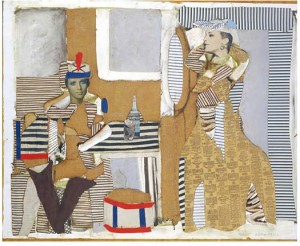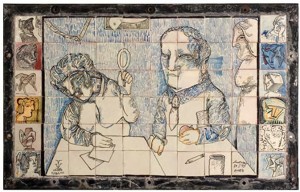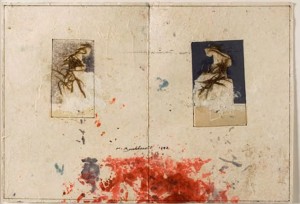I was not planning to review another Jack Rutberg show so soon, but he continues to organize exhibitions well worth writing about. The first word that came to mind when I recently entered his Gallery was “smorgasbord,” since the works of nearly forty artists are displayed. In fact, the experience was somewhat akin to going through a museum, at least, a de facto one.
All of the artists are recognized names, some iconic (Marca-Relli, Man Ray, Motherwell, Nevelson), while some are from the Gallery’s stable (Graham, Witkins). The show’s connecting sinew is that almost all of the works are collages. However, that does not mean that this many artists see collage the same way, quite the contrary, and that’s what’s so much fun about this show. Fortunately, as a result of Rutberg’s ability to hang a show (an art in itself), such a diversity of collages co-exists exuberantly without visual casualties.
Near the front entrance Rutberg hangs a stunning 1982 Conrad Marca-Relli collage of burlap, various other fabrics, and newspaper cuttings titled “The Sunday Caller.” In spite of its fading (which actually helps since most of the colors are shades of brown), it’s as powerful today as it must have been when first created. The impact of the composition becomes clear when you step away from the collage and realize that it could easily have been a painting.
Also near the entrance hangs a splendidly made 1970 collage that could easily be taken as an actual hard-edge painting on raw linen fabric (I admit, I was fooled) by Stanley Boxer, made up of asymmetrical stripes climbing a narrow, tall, vertical canvas.
When I first bumped into Edward Kienholz’s “Back Seat Dodge ‘38” at LACMA in the early ‘60’s, I understood that abstract expressionism had died. Such an experience guaranteed curiosity about the Kienholz works in the show. The first, a 1977 small television (created with Nancy Reddin Kienholz) as a jerry can with a set of bunny ear antennas and a counter behind the screen ticking out seconds, did not surprise me. But the second piece did: a 1956 not overly refined construction piece assembled from scrap wood, a twisted saw blade, and some popsicle sticks sitting on a typical abstract expressionistically treated background. I had never seen the pre- Dodge -’38 side of this artist, I didn’t even know it existed; imagine, a Kienholz when he wasn’t, well, Kienholz.
But this Kienholz surprise was nothing compared to a large 1993 piece constructed of separate tiles forming a single image in the center area by Jose Luis Cuevas and entitled “La Carta.” As a long-time fan of Cuevas, I’ve never encountered anything but drawings or prints, and neither has Rutberg or anyone else I know. It’s a beautiful piece that displays his unique style, just as impressive as his works on paper.
Halfway through the gallery one encounters more gems such as Mark Toby’s 1974-5 mixed media palette. What artist has not at some time glanced at their painting palette and thought it looked better than the painting on the easel.
There’s also a small collage by Hannelore Baron, one of the most accomplished artists in this media; her works are consistently strong, sensitive, and brilliantly composed. In spite of Baron’s amazing work, Hans Burkhard’s small 1992 untitled collage stole the show. The piece consisted of two small, side-by-side, tilted off the vertical, detailed packed rectangles floating in a minimal environment that displays immense visual power in such a diminutive work.
Towards the end of the Gallery hangs Huguette Caland’s 1997 untitled painting that consists of two long, thin, separate canvases placed side by side. That it unintentionally brings to mind the 9/11 twin towers well before the event is a bit unsettling. Viewed up close, Caland’s brilliant treatment of surfaces becomes apparent.
Finally, it would be impossible to miss spotting a good size 2007 collage (pencil, acrylic, oil, gold leaf, vellum) by Tom Wudl, the person who single-handedly showed me what it meant to be an artist. Entitled “Henry Flower AKA Leopold Bloom in Nighttown,” the collage juxtaposes Andrea Mantegna’s Saint Sebastian, at least from the neck down, to include every single arrow in the corpus, along with elements from the artist’s own imaginative iconographical lexicon. Wudl is all about the phantasmagorical creations of puns, parodies, allusions, and stream-of- consciousness. In this particular image, the clubs, eyes, breasts, lips, and chapeau make sense only because of the title. Leopold Bloom, the protagonist of James Joyce’s Ulysses who uses the pseudonym of Henry Flower, is accompanying Stephen Daedalus to a Dublin brothel. Like his Laurel and Hardy series, Wudl’s exacting representations and abundance of surrealistic detail make it difficult to know where the line between tongue-in-cheek and gravitas lies. Having had the good fortune to work with the artist for a two-year span, I can safely say that Wudl is a study in polarities: transparently obvious at one level yet opaquely mysterious on another, and I highly suspect that’s exactly where he wants the viewers who enter his Universe.
Try not to miss seeing Jack Rutberg’s exhibit before its closure after May 31.




